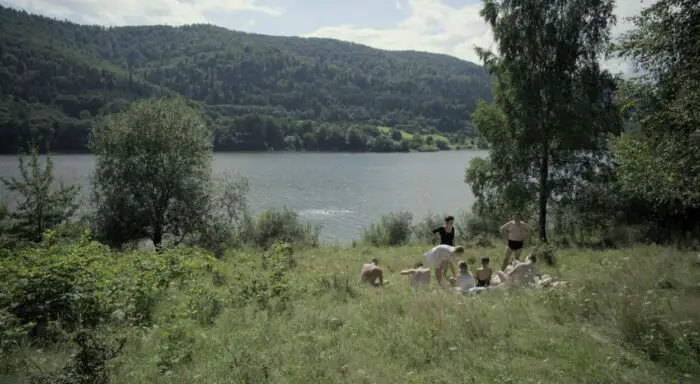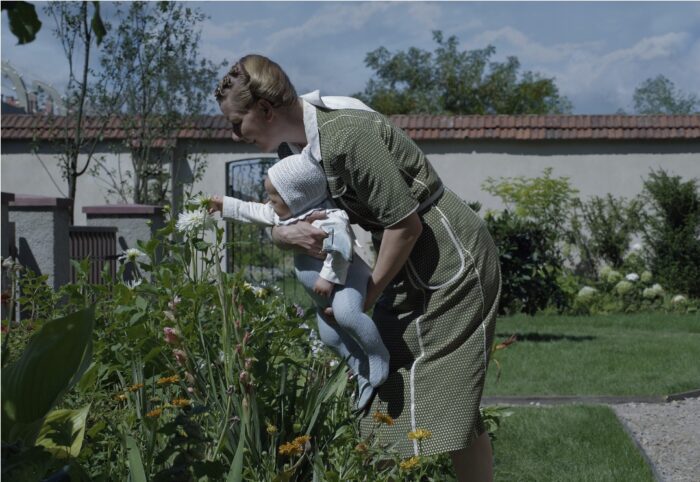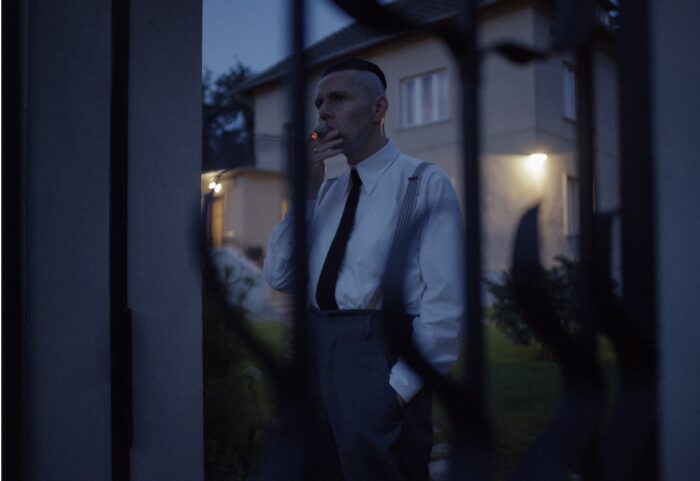The Zone of Interest bears a telling title, alluding to how human existence circumscribes its attentive absorption and awareness of the world. To take an interest in something is to find it of eminent value and worthy of engrossment. In taking up one’s regard, the object of focus becomes isolated, bordered, and emphasized. Meanwhile, the things outside our zone of interest are deemed unworthy of our time, and this demarcation can speak volumes about our humanity or lack thereof.
To this degree, modern Westerners are all guilty of the banality of evil in a globalized world insofar as we deflect attention from the horrors of warfare, economic disparity, starvation, and a bevy of other social ills we could hypothetically focus on and immerse ourselves within for every moment of every day. To a certain extent, the fortunate class retreats into the microcosms and bubbles of immediate interests, girdling and compartmentalizing attention in localized tasks, selfish ambitions, and trivial distractions to avoid constant despair.
That said, there are tiers of evil, and The Zone of Interest catalogs an evil that transcends mere avoidance. The evil here is not just guilty of complicit obliviousness, bureaucratic iniquity, and callous indifference, even as those qualities are still present and on full display. With dramatic restraint and a faux-scientific approach seeking an impossible objectivity to the material, Jonathan Glazer gradually lets us know that there is something not only mundanely nefarious about a family of Nazis living in Auschwitz but something downright sinister as well.
The mere juxtaposition of domestic bliss in the shadows of unspeakable horror is enough to make one nauseous with unease. To add to this bilious sensibility, Glazer’s overtly clinical gaze serves to heighten the impression of dismissive evil at play: privileging, via the camera’s mechanical eye, the same preoccupied deflection that marks his subjects’ willful disregard for their Auschwitz neighbors on the other side of the stucco, barbed wire topped walls. The art matches the psychology of the family onscreen, ever fixated on domesticity to eschew the horrors occurring in close proximity.
The obviousness of this repugnant contrast is evident throughout. Gunshots pepper the air as kids giddily yell and run around a tidy, rectangular pool. A small, naïve German boy rolls dice and plays with toy soldier figurines while Jews are noisily slaughtered in direct view from his bedroom window. Screams of palpable anguish pierce the night, interrupting the much less awful wailing octave of an upset baby. A canoe is gifted to the family patriarch, who serves as a cog in the Nazi Party.
Smoke permeates the periphery—from incineration chambers, cigarettes, and locomotives. Accordingly, these varied iterations of smoke speak of multitudes—one of genocide, another of reprieve, another of technological progress. Much like the twisted proximity of this idyllic, Auschwitz-adjacent family sanctuary, the world is rife with unjust dualities and stark differences that are easier suppressed and distanced via deranged mental gymnastics. Cruelty, including mass murder and torture, is simpler to externalize or censor as an alien thing. The contrition conjured up by a victim is simpler to vilify, and these craven acts reinforce the latent culpability of all those who enjoy the spoils of life on the fortunate side of the fence.

Incrementally, we realize that Hedwig (Sandra Hüller) and Rudolf Höss (Christian Friedel), the family patriarch and matriarch at the Auschwitz home under scrutiny, exhibit something much more insidious than shirking conscientiousness, showcasing vile motives by not only flouting the massacres occurring at Auschwitz but also perpetuating the system for personal and professional gain. However, Glazer is gradual in his approach, incriminating Hedwig and Ross with subtle nonchalance.
In fact, the first part of the film avoids anything directly condemning on purpose, slyly and deliberately humanizing the film’s central couple by painting broad strokes of domestic bliss. We see Hedwig and Rudolf as fairly ordinary parents: doting over their bounty of kids, planning trips to an Italian spa while lying in bed, waxing nostalgic by retelling anecdotes of an accordion playing music for the cows, and so forth. Most middle-class moviegoers see the couple as a mirror insofar as their marital and family life reflects an abounding sense of normalcy.
This is not to say that Rudolf and Hedwig ever feel exonerated from the genocide transpiring just a stone’s throw away. But it isn’t until Rudolf is shown mapping out plans at a table—intellectually developing the rigorous protocol of operations at Auschwitz with disturbing focus and meticulous efficiency—that we understand his full culpability. Likewise, Hedwig’s abject evil is unveiled so matter-of-factly and underhandedly interwoven within the tapestry of household activities that it is easy to oversee for some time.
Far from merely yielding in compliance, she threatens (under her breath at the breakfast table) to send a Polish servant to be burned for a trifling error in her household duties. She doesn’t flinch when her mother spitefully wonders if a Jewish neighbor (who outbid her in curtains) had been sent to Auschwitz. Later, she symbolically burns her mother’s guilt-riddled goodbye letter after the latter’s conscience resurfaces (presumably during a nighttime scene where she is seen staring glumly out a window, bathed in the red glow of flames).
What is so unnerving is the conflation of the two sides of the Höss family—their domestic averageness and the heinous insouciance with which they go about assimilating and abetting atrocities into their daily routines. Rudolf is as passionate when he lectures about the grave importance of plucking lilac flowers properly for the betterment of the community as he is when he speaks of spending a Nazi party enthralled and perplexed by the logistics of optimizing a voluminous gas chamber’s murderous efficiency. Hedwig, meanwhile, is reasonably concerned about nurturing her hale and healthy progeny, but there’s something deeply troubling about the steely resolve she insists on staying in Auschwitz and her blinkered attitude toward her infernally-fringed “oasis.”
This is especially foregrounded when we see the children normalizing sadistic behavior. Already engaged in the cycle of abuse, we see one boy lock his younger sibling in a greenhouse out of nothing more than mean-spirited glee. Moreover, the scattered human remains and detritus—teeth, rings, etc.—around Auschwitz are treated as mere discoveries. The sight of kids cozily playing in their bedrooms with the toll of genocide is haunting, subtly showing how they are subconsciously and innocently inheriting a cool detachment from the price of war and ethnic cleansing. Even the bedtime Brothers Grimm readings of Hansel and Gretel (a fairy tale prominently featuring the iconic scene of youth tricking a witch into the oven) indicate a subliminal attempt to assuage and ameliorate the pangs of ambient penitence in the children.

Serving as the film’s sole counterpoint of empathy and compassion, a nearby Polish girl hiding apples in the soil and beneath shoves for Jewish workers. Shot with thermal imaging and shimmering like a negative in photography, this character is the visual inverse of the Höss family. Captured with night-vision technology, her small but meaningful gestures of charity appear with dreamlike clarity—flowing and unreal, like a spectral projection of lucid dreaming. In contrast to the glaring brightness of the daytime domesticity, her nocturnal existence is surreptitiously philanthropic, indicating a period of German history where acts of mercy and kindness could only transpire under the clandestine cloak of darkness.
On one moonlit outing, this Polish girl disinters a small, folded-up letter with a poem inscribed upon it. The resulting poetry is not merely fiction. The words are an artifact: Joseph Wulf’s Yiddish song ‘Sunbeams,’ composed at Auschwitz. Very cinematically—via a synesthetic maneuver of magical realism—the Polish girl symbolically transcribes the verses within by playing corresponding notes on the piano. Representing the metaphysical and spiritual steadfastness of the Jewish community, the poem chillingly echoes the grim contrast of glorious sunbeams and deleterious inhumanity on display in Glazer’s cinematography.
Revealed solely in subtitles (without a single utterance), each syllable of the poem syncs with a piano key, as if conveying the ineffable yet pervasive resilience and misery of the victims at Auschwitz. The conceit is tragic and incisive in a way that tingles the spine. Without a proper voice, the plaintive cries and screams of the poem thus find themselves sublimated into the universal and eternally persevering sound of music: “We who are imprisoned here, are wakeful as the stars at night. Souls afire, like the blazing sun, tearing, breaking through their pain, for soon we’ll see that waving flag, the flag of freedom yet to come.” In the timbre of somber piano keys, the language of the silenced and aggrieved finds a sublimated outlet of long-lost agency.
Throughout, the Höss household is immune to the compassionate laws of any such musicality— bereft of scrupulous self-reflection, devoid of moral compunction. The family is both stereotypically average and inhospitably sociopathic—pathologically remorseless toward the horrors transpiring in the background of their opulent, albeit otherwise banal, existence. At its most trivialized, the horrors of the neighboring concentration camp interfere with their afternoon activities, such as when Rudolf finds a jawbone in the river and rushes to retrieve his kids from swimming. (For what it’s worth, there is considerable evidence of unconscious guilt as they frantically scrub their kids in the bathtub after this outing, as if burdened with trepidations about contaminating their kin with the evil they’ve committed.) At its most disturbingly utilitarian, the horrors next door offer nutrient-dense fertilizer in the form of human ashes.
Clearly, in each scenario, Rudolf and Hedwig are not merely acquiescing with begrudging cowardice—they are emblems of Nazism, basking in the power of their respective positions, which come at the gravest expense of human indignity and suffering imaginable. This is drastically different from the still culpable but exponentially more nuanced, sympathetic, and relatable circumstances where evil is ignored out of fear, utter ignorance, or as a survival mechanism—in situations where state-inflicted wickedness is rejected internally but accepted as a necessity and abstracted to persevere—passively reinforced to sustain a sense of social poise and sanguinity.
While such a permissive stance is still highly censurable, it is not quite commensurate. Such passivity is at least multidimensional, especially when humanely counterbalanced by soberly reflecting on the transience of power, the iniquity of apathetic overabundance, and the consequences and costs (intentional or not) of living well. There are degrees of blameworthiness, and collusion is not equal to obedience. Intentions matter, and self-loathing/examination can at least foster eventual abnegation. There is a way to live in relative prosperity with a modicum of dignity and diplomacy—recognizing the ever-present task of respecting and commiserating human misery. This way of submissively coping with complicity is passively evil, whereas the parents at the center of The Zone of Evil are actively and unequivocally evil.
Despite the banality of their routines, Rudolf and Hedwig far surpass the bureaucratic complacency Hannah Arendt was referencing and indicting when writing Eichmann in Jerusalem. Here, the two figures are irredeemable agents of genocide. What humanizes them is not the existence of some long-abandoned moral compass but how middle-class and domestically ensconced they appear. They are all the more disturbing for their normalcy, which consequently links the abundance of raising a nuclear family with the extreme existential costs of a remote or not-so-remote party.
What’s ostensibly most upsetting about the two is their palpable moral fluidity and what this means for the human condition. They highlight the heart’s capacity to compassionately pamper one living thing (whether it be a child or a garden) with careful consideration and solicitude while annihilating another ethnic group in the periphery/background; they exemplify the mind’s ability to partition two concurrent and diametrically opposed worldviews with considerable ease. To make matters more icy and murky, Glazer maintains a static, neutral, unfeeling attitude toward the material—coldly and clinically chronicling the quotidian commotion of the Höss household from a phlegmatic remove.
The stolid cinematography accents the ennui beneath the horror—flattening the dramatic and the tragic with an anti-affective tone and forging a dispassionate polemical vacuum that inversely works to magnify the overall sense of fury and distress. Approaching the film with a sharp, immobile, stationary focus—both morally and visually—Glazer’s author-less distance and immovable lack of telegraphed judgment places the burden of ethical untangling on the anxious viewer. While the proceedings onscreen are far from ambivalent, the familiarity of the domestic rituals (swimming, gardening, celebrating birthdays), paired with the horrific backdrop, offers an abrasive contrast that makes one queasy.

The unsettling provocations resulting from Glazer’s arch treatment and moral avoidance naturally open a flurry of debates on the politics and ethical responsibilities of depicting the human abominations of the holocaust. Glazer shrewdly deflects much criticism by subduing his authorial presence and making every effort to avoid meddling. Collaborating with cinematographer Łukasz Żal, Glazer notably rigged and hard-wired ten fixed, stationary, mostly hidden cameras in the Höss household and then filmed the action by virtue of focus pullers stationed in the basement—becoming performatively oblivious like the characters onscreen being voyeuristically shadowed.
One objective of this methodology was to achieve a poetic naturalness in the household, a graceful realism in the family’s daily domestic movements; another objective, ostensibly, was to achieve a gaze of neutrality. Whether this aim is ever possible, however, seems dubious at best. Despite its crafty and circuitous cinematographic approach, The Zone of Interest can’t escape its central fabrications and storytelling thesis. It is clearly a film with a dramatic, moral, and narrative outline, and as such, it is bound to incite a dialectic about the tact vs. tackiness of tackling this material in any format or context.
Deflections and cinematic sleight-of-hand aside, one is stuck sitting with a sickly and vertiginous feeling by the time the sound design’s ambient hum of distortion and dissonance (accenting pitch blackness onscreen) slowly segues into the credits. Regardless of the thoughtfulness and structural layers, one is left quietly stunned and overwhelmed, wondering if a holocaust film can ever honor the fathomless horrors of such a dark period of history. Can a fictive reenactment ever justify itself in the face of unspeakable horror? Is not every narrative exercise surrounding such a topic, by default, undone by its essential flippancy and artifice? Is a tasteful exercise in reserved detachment graceful or even more inappropriate? Does the cerebral and emotional approximation of such a horrid reality reduce the hellish dimensions to a reductive simulation? Just as one might critique Spielberg’s Schindler’s List for being too conventionally dramatic or entertaining, The Zone of Interest feels doomed to be received as too formally calibrated and manicured, even if such affects/effects are part of the film’s intellectual power and moral design.
There is truly no way for Glazer to eschew or escape the perils inherent in producing an aesthetic deconstruction of “quotidian” Nazism with a cinematic exactitude that doesn’t also underplay the gravitas. Ineluctably, the film sanitizes the ineffably terrible period of history into a semiotic system, therefore stripping it of its unthinkably visceral hideousness. Just as Schindler’s List feels too sentimental and maudlin, Glazer’s approach is destined to be too intellectually riveting and visually engaging. Regardless of the directorial angle—confronting the holocaust with melodramatic sincerity and formalistic complexity—the presentation is bound to appear resoundingly flippant for the abysmal gravity of the subject matter.
The pictorial imagery may dilute the visceral terror, but Glazer’s manicured approach is neither cavalier nor reproachable. Far from it, The Zone of Interest is a painstaking work of painful fiction, reviving a nightmarish slice of history with excruciating sobriety. It forces contemporary audiences to grapple with the existence of evil in uncomfortable ways. If there is no way to recreate such atrocities properly, the justification of such storytelling is highlighted by the even graver error of failing to remember the holocaust altogether. Awkwardly sangfroid and structurally stunning as The Zone of Interest may be, it is never an easy viewing and is purposely icky. The more amiable the film becomes, the more elevated the sense of foreboding. A lurking dread fills the negative space, haunting the audience with an arrant absence of moral clarity and accountability.
Glazer finishes the film with a startling gesture of critical reflection—self-consciously recognizing the very ethical quagmire and narrative stalemate he’s stuck operating within. Though jarring initially, Glazer’s astute decision to end the film with a metaphorically layered and textually loaded leap forward in time is extremely complex. After retching multiple times while walking down a staircase, Rudolf suddenly stares down a hallway. Suddenly, the film transitions to a pinhole of light that segues to a present-day setting, capturing a janitorial crew as they vacuum, dust, and clean the surfaces of a holocaust site/memorial.
Functioning as a self-incriminating coda, this narrative gimmick is risky but potently effective in both excoriating and exculpating the existence of the film itself (operating much like the Martin Scorsese cameo at the end of Killers of the Flower Moon). The images of the workers wiping placards and scrubbing glass windows (encasing piles of holocaust victims’ shoes) create a swell of polarizing reactions. Much like The Zone of Interest, Glazer stonily chronicles this cleaning crew’s routine to acknowledge the morbidly sinister underpinnings of the task. As the workers scrub, wipe, and clean, the sacrilege in preserving the horror of terrible things becomes apparent, while the necessity of preservation becomes equally true.
To further the parallel, the janitors work in a fastidious frenzy to keep the space spotless and pristine—squeaky clean to pay tribute to the past with an air of well-kept sterility and disinfected purity. This creates an undercurrent of reverence intermixed with the perfunctory, a dichotomy that doubles as a defense of the film and a self-indictment simultaneously. With brevity and nauseating disquietude, the epilogue thus questions the project of formal, public remembrance. It examines whether reimagining and embalming relics bearing such horrible historical significance and intimately personal anguish is the proper way of paying memory and tribute to the victims’ legacy.
On the one hand, museums, documentaries, and heirlooms satisfy the human need to preserve our worst failures as a species to avoid repetition and recidivism (at least, that’s the excuse we like to use to pretentiously distance ourselves from atrocity while enjoying an abstract space of social equilibrium and thus unfair moral authority and control over such things). On the other hand, there is something intrinsically perverse about our curiosity in confronting abject agony as a cathartic release. The ethical prickliness of remembrance is endlessly thorny. Nevertheless, grappling with horror is ultimately how we reform ourselves and make peace with past sin and forgotten evil—staring soberly at its fathomless depths and contradictions with the gaze of unflinching, calculated honesty is the only way to see our full potentiality in both its decorousness and its depravity.



